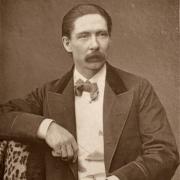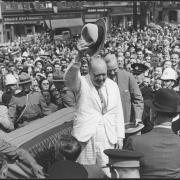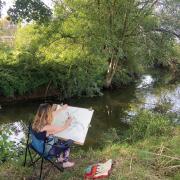Stephen Roberts introduces us to prolific portrait artist John Singer Sargent, whose most famous painting was conceived in the bucolic beauty of Broadway
I often feel that a person’s birthplace is the least significant part of them. Of far greater import is what they bring to the party. Take John Singer Sargent (1856-1925), an American by conception, a Florentine by birth, an artist by nature, and whose most famous painting was conceived in Broadway (that’s Worcestershire not New York).
John was born on 12th January 1856, the son of an American eye surgeon, Fitzwilliam Sargent (1820-89), and Mary née Singer (1826-1906), hence his middle name, which makes people not in the know wonder whether he might have had something to do with sewing machines. John’s destiny was not to be born in the US. The death of John’s elder sister when she was just two caused his mother to suffer a breakdown and prompted his parents to travel abroad as their way of coping. Although home was now primarily Paris, they’d move around season to season, and they happened to be in Florence when John popped out.

Sargent studied art in all of Florence, Germany, and Paris, where he learned from Emile Auguste Carolus-Duran (1838-1917) between 1874-78 and first gained recognition for his talent, an 1879 portrait of his mentor really announcing his arrival. One 1880s submission to the Paris Salon, ‘Portrait of Madame X’, sounds a bit risqué and clearly was in some form or other as it resulted in something of a scandal, being labelled ‘provocatively erotic’, although it would remain one of Sargent’s personal favourites. It was during the next year following this setback that Sargent crossed the Channel and headed for England where he was to consolidate his reputation. Despite his rather eccentric origins and upbringing, the main body of Sargent’s work would be produced in England where his ability elevated him to be the most fashionable portraitist of the time, including that brief Edwardian era which he depicted in luxurious fashion. As well as portraits in oils, he was a talented landscape artist and watercolourist. He’d churn out around 900 oils, over 2,000 watercolours, and numerous sketches and charcoals during a prolific career, however, his most famous piece, his magnum opus, was one conceived in the Cotswolds.

Sargent’s first visit to Broadway was in September 1885. He was convalescing after suffering a nasty head wound sustained whilst diving from a weir. Please don’t try that at home! Sargent had actually received a personal invite from another American artist, Edwin Austin Abbey (1852-1911). Broadway was little known at the time, a tad distant from the railway line betwixt Cheltenham and Stratford but had nevertheless become home to an artists’ colony rather like Newlyn in Cornwall, during the 1880s. Many of these brandishers of the brush were ex-pat Americans. It was whilst in Broadway, of all places, that Sargent was to paint perhaps his most popular artwork of all: ‘Carnation, Lily, Lily, Rose’. The two little girls featured in the painting, the delightfully poetic Dolly and Polly, were daughters of illustrator Frederick Barnard (1846-96) who lived in Broadway over 1885-86. Sargent became very much a key member of ‘The Broadway Group of Artists’.

Broadway had been ‘found’ by another American, the illustrator and painter Francis Davis Millet (1848-1912) who was to perish in the ‘Titanic’ tragedy. 140-odd years ago this quintessential bit of olde England enchanted the Yanks much as it does today. It was a time when quiet corners of the country attracted artists in their ‘groups’ who could be inspired by the solitude, the vista, and presumably by some cross-fertilisation. What motivated many of these artists was capturing the light and shade of these pastoral havens, echoing the achievements of the French Impressionists who’d also headed for rural bivouacks. Millet had first occupied Farnham House, overlooking the village green, but then also acquired Abbot’s Grange, a former priory and monastic ruin just around the corner, which was restored to a state befitting an artists’ studio. The grapevine did its business and Millet was soon joined by a plethora of artists, including Sargent, plus London-born architect Arthur Blomfield (1829-99), who set up home in Springfield House and lies buried in Broadway, but also writers such as Henry James, whom Sargent painted (1913), and J.M. Barrie.

We authors need inspiring too. Composers also gravitated here, including Elgar and Ralph Vaughan Williams as well as the Arts and Crafts guru William Morris. Sargent’s preferred spot to pitch his easel was just outside as he became a devotee of painting ‘en plein air’. When he’d first visited, he’d stayed at the Lygon Arms, which would continue to be the favoured hostelry for the visitors to the Group; Sargent would soon be ensconced at the Grange though. The collective lifestyle was of a Bohemian persuasion with locals looking on askance. If you’re unfamiliar, ‘Bohemian’ might involve a liberal degree of boozing, sometimes running amok, and the wearing of floppy hats. Okay, I’m in. There was also plenty of music with Sargent revealing a particular love for Wagner.

Edwin Austin Abbey would eventually purchase an old country house at Fairford, 40 miles to the south of Broadway, and was able to entice Sargent away from Worcestershire. Henry James would eventually follow them, unsurprisingly perhaps, as he’d always remained a bit aloof in Broadway as though the whole escapade was a bit beneath him, and the net result was that the artistic heart had rather been ripped out of the Worcestershire Group which then slipped into a decline from which it wouldn’t recover. For all the ambience, atmosphere and avant-garde high jinks, there were few really remarkable pieces of work produced by Broadway, one notable exception being Sargent’s ‘Carnation, Lily, Lily, Rose’: a true masterpiece.

During the 1890s Sargent was averaging around 14 portrait commissions a year, the average fee being around US$ 5,000 (just to give you an idea, that sum of money in 1895 would be the equivalent of more than US$ 180,000 today). He was elected to the Royal Academy in 1894 and became a full member in 1897 when he was just over 40 and come 1905, he’d be commissioned to paint the 9th Duke of Marlborough, his American wife and associated children, which, of course, brought him to Blenheim Palace. Although a lot of work was completed here, his early art nevertheless betrays the French influence on his life whilst Spain also played its part as can be seen in his ‘Carmencita’. In fact, Sargent’s life’s work shows the influence that travel had on his brushwork which was apt enough considering the circumstances of his birth; Italy, Spain, the US, the Middle East and England all played their part.

Sargent certainly didn’t ignore his roots across the Pond, and he frequently returned to the States where he painted portraits, as was his wont, but also turned out decorative artwork for public buildings, an example being his ‘Evolution of Religion’ for Boston Library, the Boston work enabling him to collaborate once more with his old mucker Mr. Abbey. This is the kind of art Sargent turned to when he became disaffected with the demands of portraiture. In later life Sargent veered from portraits to work on landscapes, often using watercolours, but it will forever be his portraiture that he will be chiefly remembered for; their lively and elegant style stands out.

John Singer Sargent died on 14th April 1925, aged 69, his final resting place to be Brookwood, the huge cemetery created to help solve London’s overcrowding problem. What kind of person was Sargent? Essentially, a very private, shy man, yet accomplished and charming. He never married but was dedicated to family and friends. You may wish to check if you have a Sargent gathering dust in the attic. His 1905 ‘Group with Parasols’ (A Siesta)’ sold a century later, in December 2004 for US$ 23.5 million.

CHRONOLOGY
1856 – John Singer Sargent born in Florence, Italy (12th January).
1879 – Portrait of Sargent’s French mentor, Emile Auguste Carolus-Duran, marks his arrival.
1885 – Sargent first arrives in Broadway, staying at the Lygon Arms.
1897 – Becomes a full member of the Royal Academy.
1905 – Heads to Blenheim Palace to paint the 9th Duke of Marlborough and family.
1913 – Sargent paints the author Henry James, one of the members of the Broadway Group.
1925 – Death of John Singer Sargent in London (14th April) aged 69.
2004 – ‘Group with Parasols (A Siesta)’ is sold for US$ 23.5 million.



























